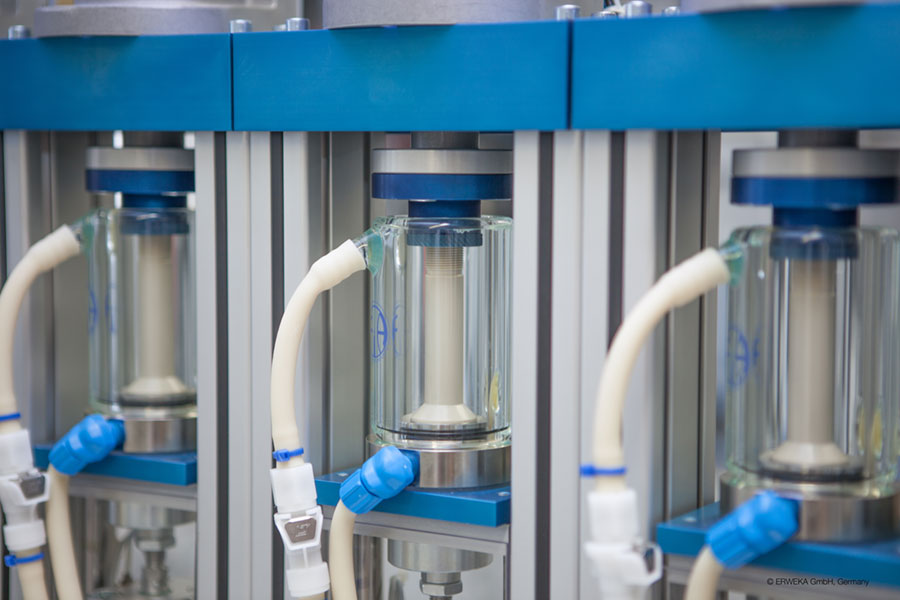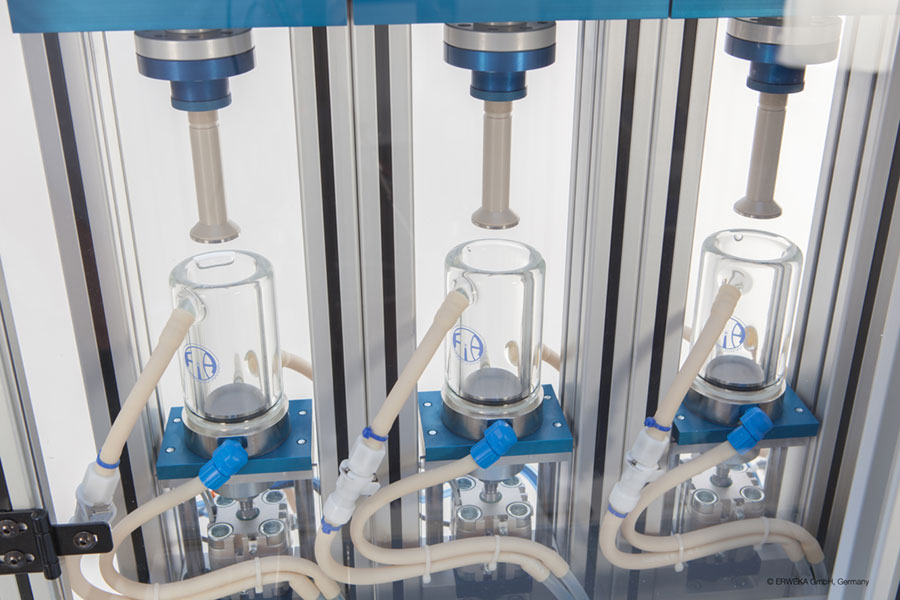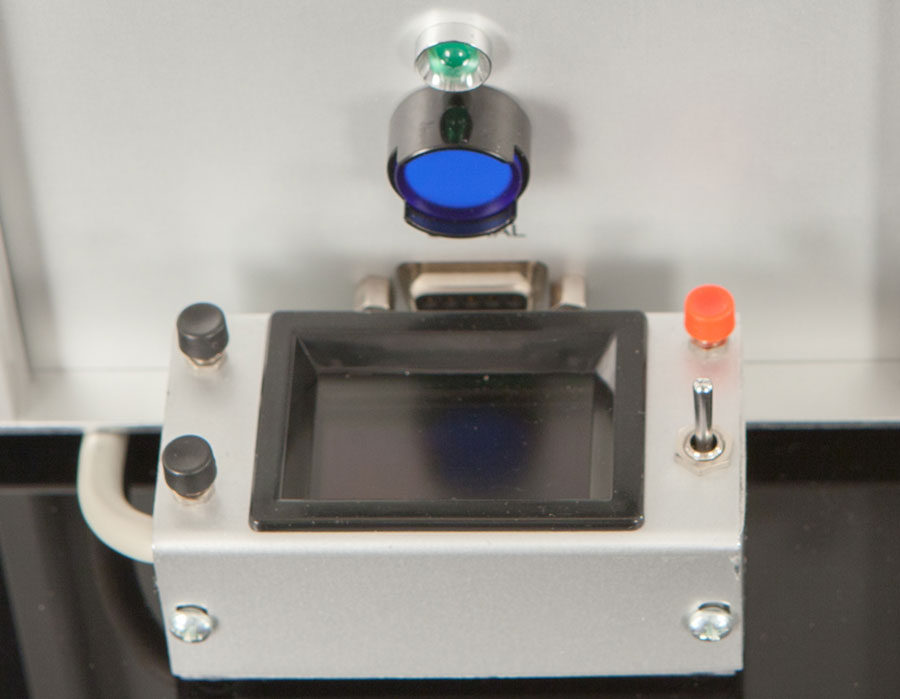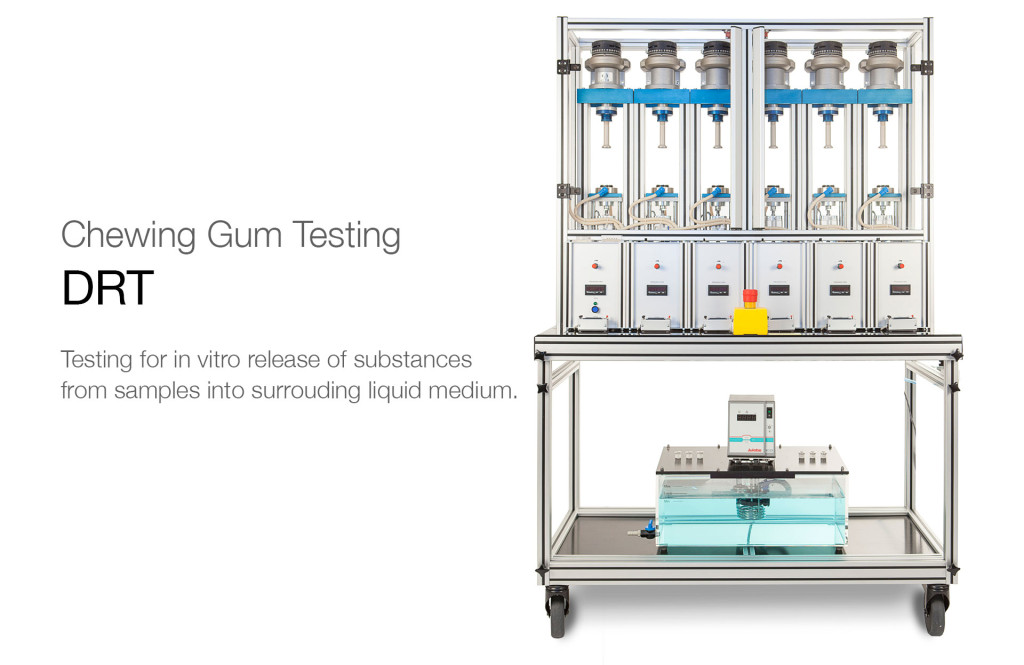
ERWEKA DRT Overview
DRT dissolution testers are equipped to masticate chewing gums, especially medicated ones, for the invitro release of substances from the samples into a surrounding liquid medium. Up and down strokes (vertical) of the lower jaw in combination with a revolving movement of the upper jaw which provides mastication of the chewing gum and at the same time an agitation of the test medium.
For manual sampling, emptying and cleaning process the lower jaw with the test cell can be lowered into the down position and the chewing process stops. The test cell, the upper and lower jaw can be easily removed. The temperature of the water in the test cell around the media will be controlled by a water circulation system. The chewing gum test apparatus is used to chew gum and then analyses the speed at which various substances leave a gum (release). The apparatus is also very helpful to develop candy chewing gums. Also a few odd applications are possible such as testing of snuff bags etc. and in a special design, controlled mort development of tablets.
As the DRT offers a modular design, any number of chewing gum can be tested at the same time, with the DRT-6 with 6 test stations the most commonly used. The cells can be equipped with accessories for measuring the pressure of chewing gum, torque at shear force (twisting motion), pH, temperature, etc. All measurements are logged into a data logger which can then be printed.
Download the DRT Spec Sheet here.
Approach
Chewing sequence: Chewable sequence consists of the upward movement of the lower jaw in combination with rotary (sjuve) movements of the upper jaw resulting in an adaptation of the chewing gum and stirring of the release liquid at the same time.
The upper jaw has an underside which is plane parallel with the central part of the lower jaw. The lower jaw has an edge that is angled upward at 45 degrees as a small flat-bottomed bowl. Bowl shape prevents the gum from slipping off during processing.
Method
Chewing: A chewing gum is placed between two nets in the bowl of the lower jaw and the glass vessel is filled with fluid. The chewing gum is then processed (chewed) for approximately half an hour.
Sampling: The lower jaw with the test cell is lowered using the lift. In its lowered position the unit is free from the upper jaw, which facilitates manual sampling, emptying and cleaning after analysis.
Cleaning: The test cell and the lower and upper jaw can be easily removed and cleaned or can be replaced by clean elements, enabling a large number of test runs each day.
By default, we deliver:
- Chewing apparatus with 6 test cells
- Chewing apparatus with 1 test cell
- Chewing apparatus with 2 test cells
- Chewing apparatus with 3 test cells
- Chewing apparatus with 3+3 (6) test cells
All of the chewing apparatus is provided with protective box and placed on a cart, but also chewing apparatus for placement on the laboratory bench is offered. However, we recommend the “cart” model. Test Cells with pressure control/logging. PH and temperature logging are also available for all models.
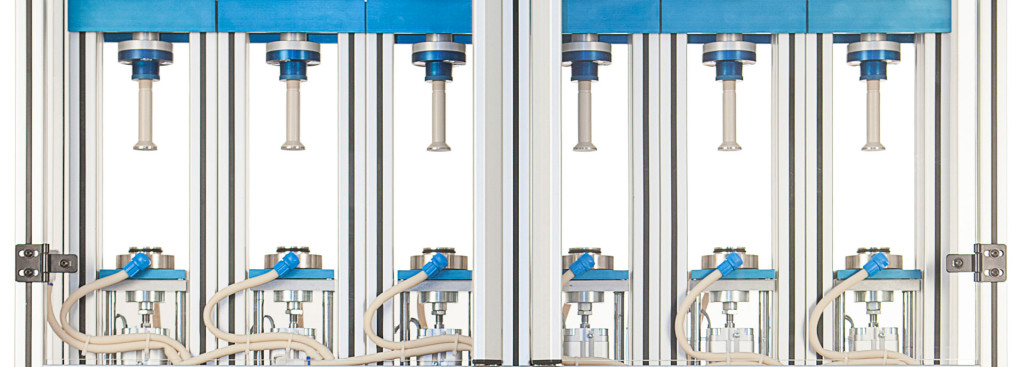
DRT Options
The dongle HPJ makes the chewing apparatus (after a brief pause) continue their chewing cycles, although the chewing cylinder does not reach the set gap of the jaws. The dongle is useful when eg. have thick or very hard gum and the device does not have the power that is consumed (> 60N) to deform the gum during the first chewing sequences where the apparatus normally stops. Consumption: 1 / test cell
With the optional HPJ+C you can set the desired number of chewing cycles and when set value is reached the current test cell is stoped. Also contains the function of HPJ. Consumption: 1 / test cell
Specifications
DRT
- Chewing gum tester DRT with 1 to 6 test stations (DRT-1 to DRT-6)
- Revolving device for upper jaw: Pneumatic drive unit, compressed air 6-8 bar, compressed air to be supplied by customer. The angle of the revolving movement can be adjusted between 10° – 180°
Test cell
- Double-walled and made of glass which allows visual inspection during the test
- Volume for dissolution medium 20-70 ml
- Temperature controlled by a water circulation system
- In- and outlet nozzle for the water circulation system, Test Cell can be easily removed for cleaning or changing.
Upper Jaw
- Revolving according to the revolving device, no up and down movements
- Mounted on a heat insulated holder
- Can be easily removed for cleaning or changing (recommended after each test)
- Distance of upper and lower jaw in closed position adjustable between 0-10 mm
- Acid proofed stainless steel with blasted surface for a better grip
Lower Jaw
- Lifting according to the device for up and down movements:
- No sliding of the sample during mastication due to the design of the jaw and due to separate nets between the jaws
- Metal in contact with lower jaw tempered by the circulated water
- Acid proofed stainless steel with blasted surface for a better grip
- Can be easily removed for cleaning or changing.
General
- Device for movements: Vertical pneumatic cylinder, compressed air 6-8 bar, compressed air supplied by the customer
Movement frequency adjustable between 20 – 60 cycles per minute - Temperature controlled water bath can be regulated between 25 – 45 °C. One water bath for up to 6 test cells, volume 25 litres, made of PMMA acrylic glass. Electronic pump for continuous circulation of the heated water.
- Mobile carrier for easy transport of the whole equipment. Two level carrier with rubber wheels. Made of aluminium
- Electronic control of each test cell individually
- Control of movement frequencies, operation time, temperature and warming up period, no product memory, parallel and serial interface available currently
- Power 230 VAC, 50/60Hz, 1000 VA (W)

